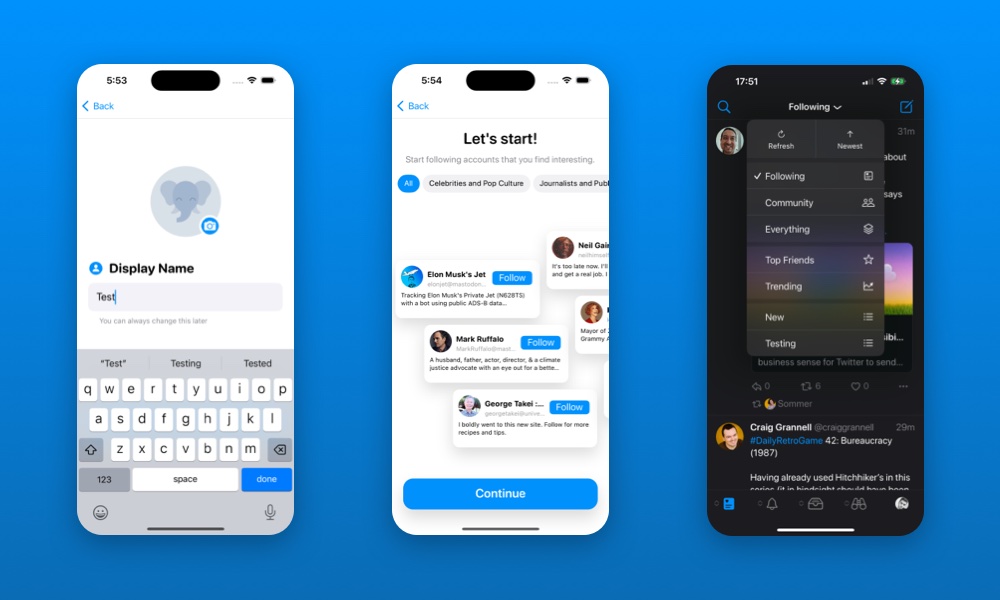
Mammoth is a free Mastodon app for iOS that makes it easier to get started
Reading Time: 4 minutesA new Mastodon app called Mammoth has already gained 10,000 downloads in the first few days of its availability on the App Store. The app was built by a team that includes the developer of the Aviary app for Twitter, which was among those unceremoniously killed by Twitter earlier this year after new owner Elon Musk decided the wider app ecosystem no longer had a need for third-party Twitter clients.
That decision left longtime Twitter apps in the lurch but prompted several app developers to turn their attention to the open-source, decentralized social network Mastodon instead. Last month, for example, the maker of the popular Twitter client Tweetbot launched a new Mastodon app called Ivory, after Elon Musk’s API changes wiped out the company’s Twitter-focused predecessor with no warning.
Now Mammoth is entering the market to offer users yet another option.
Unlike Ivory, which is an attempt to build a business to replace the losses from Tweetbot’s closure, Mammoth — for the time being, at least — is free without any in-app purchases. However, the company has said it eventually plans to offer a subscription version of Mammoth and its community, moth.social, but it hasn’t yet settled on the details.
In the meantime, its near-term goal is to encourage Mastodon adoption, the company explained in a blog post.
‘…we don’t think our subscription will be a paywall or that free users will get a read-only version of the app or moth.social. Simply: we want to contribute to Mastodon having 10m active users, then 100m. It’s early days still, and we don’t want to do anything that slows down adoption,’ writes Mammoth co-founder Bart Decrem. ‘Therefore, we likely will have a subscription, but it won’t stop you from enjoying the app if you’re not paying. We don’t have all the details or the timing figured out yet.’
At launch, the Mammoth app offers access to a broad set of baseline features, like the ability to browse and switch between Mastodon timelines; post content including text, images, GIFs, polls; use features like private messages, lists, and bookmarks; change the app icon and theme; turn on a dark mode; access multiple accounts; and even undo posts with a custom duration, similar to Twitter. There are plenty of gestures and customization options to make Mammoth feel personalized to you.
The app also has an extensive set of less common features, like thread creation tools, picture-in-picture for pinning posts to your screen, tools for viewing media in AR, tools for sentiment analysis, the ability to hide replies, translation tools while in compose, and more. As an iOS app, users can take advantage of things like Siri Shortcuts, Face ID and Touch ID, Share Extensions, and VoiceOver support. The app will soon come to macOS, too, the company notes.
What’s potentially more interesting than all of Mammoth’s bells and whistles is its approach to user onboarding.
Choosing a server has often been said to be one of the more difficult parts of getting set up on Mastodon. It adds a layer of complexity to the setup process when users expect to be able to just create a username and password like they’re used to on other social networks. But joining a server is part of what it means to participate on Mastodon and the broader group of interconnected servers known as the Fediverse, so it can’t be bypassed.
To make this process easier, Mammoth presents a simplified user interface that walks users through the account setup process, including their profile creation. It also tackles the problem of who to follow on Mastodon by presenting an interface for finding suggested users from across categories — something Twitter also did back in the day.
Mammoth launched just days ago, but its 10,000 installs indicate there continues to be consumer demand for Mastodon apps, despite the competitive landscape that includes Mastodon’s official client and a number of third-party apps, including the newly launched Ivory from Tapbots.
While some consumer interest in Mastodon may have waned since Musk’s Twitter takeover, interest in the wider Fediverse continues to grow.
Before Musk’s Twitter deal closed, the Fediverse — which includes Mastodon and a range of other social apps — had north of 570,000 monthly users. Today, the network has around 2.57 million. Companies are beginning to take note, too. Tumblr’s owner has talked of adopting the same protocol that powers Mastodon and Flickr has been considering the same. Blogging site Medium last month established its own foothold in the Fediverse with the launch of its own community.
Mammoth is bullish on the Fediverse’s potential and that of a decentralized internet in general.
The company says it will be open sourcing its code in addition to operating its own instance, and ultimately aims to make Mastodon easier for the next 10 million users, then the next 100 million. It’s an ambitious goal, given Twitter itself had just 237.8 million monetizable daily active users in the last quarter it reported as a public company, compared with Facebook’s 2 billion daily active users as of its most recent earnings. Whether or not a group of decentralized apps can ever carve out a large enough niche amid the shadow of tech giants remains to be seen. But it’s arguably a more promising development than web3, which has squandered consumer trust by enabling scammers and pyramid schemes to proliferate.
Mammoth is a free download for iPhone and iPad and will come to Mac soon.
Ref: techcrunch
MediaDownloader.net -> Free Online Video Downloader, Download Any Video From YouTube, VK, Vimeo, Twitter, Twitch, Tumblr, Tiktok, Telegram, TED, Streamable, Soundcloud, Snapchat, Share, Rumble, Reddit, PuhuTV, Pinterest, Periscope, Ok.ru, MxTakatak, Mixcloud, Mashable, LinkedIn, Likee, Kwai, Izlesene, Instagram, Imgur, IMDB, Ifunny, Gaana, Flickr, Febspot, Facebook, ESPN, Douyin, Dailymotion, Buzzfeed, BluTV, Blogger, Bitchute, Bilibili, Bandcamp, Akıllı, 9GAG